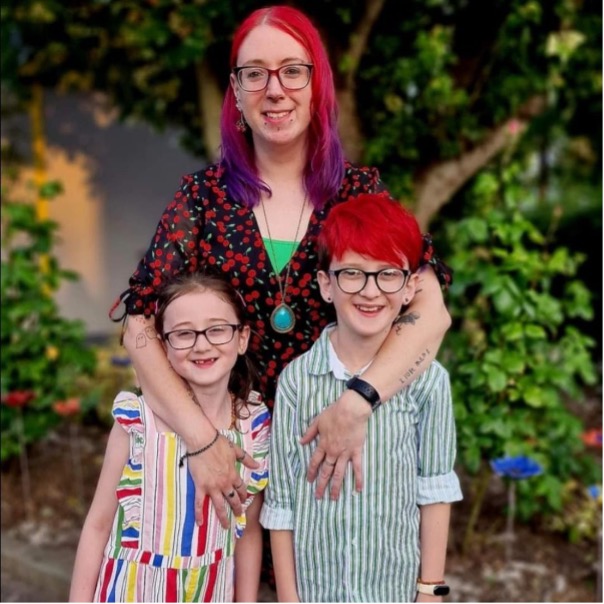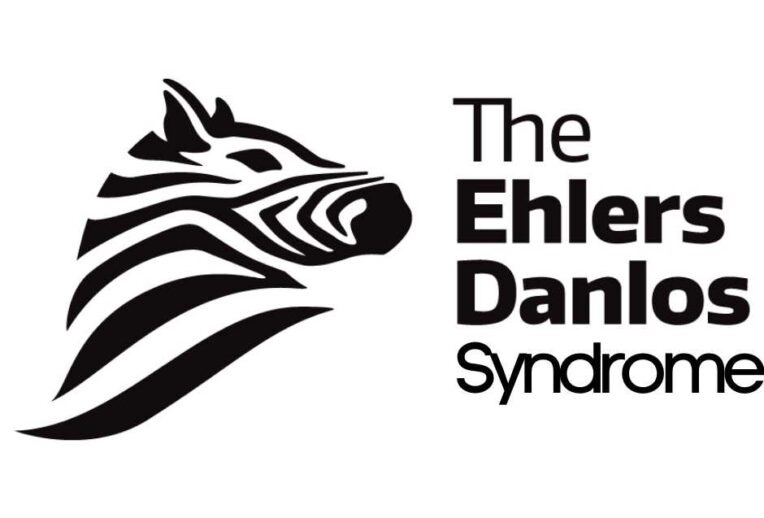‘I’m in pain 24/7, it never goes away’ – Newry mum of two Ellis Oliver shines a light on invisible disability Ehlers-Danlos Syndrome
Newry woman Ellis Oliver has spoken about her family’s experience with invisible disability, Ehlers-Danlos Syndrome, to coincide with Ehlers-Danlos Syndrome (EDS) and Hypermobility Spectrum Disorder Awareness Month.
By Paul Malone

Ellis Oliver, 39, from Newry, is mum to Noah, 12 and Jupiter Oliver, 8.
What is EDS?
“Ehlers-Danlos syndromes (EDS) are a group of rare inherited conditions that affect connective tissue.
Connective tissues provide support for skin, tendons, ligaments, blood vessels, internal organs and bones.
EDS can affect people in different ways. For some, the condition is relatively mild, while for others, their symptoms can be disabling.
The different types of EDS are caused by faults in certain genes that make connective tissue weaker.
Depending on the type of EDS, the faulty gene may have been inherited from 1 parent or both parents.
Sometimes, the faulty gene is not inherited but occurs in the person for the first time. Some of the rare, severe types can be life-threatening.”
“I went from being on the athletics team to sleeping 16 hours a day.”
Ellis Oliver, 39, from Newry, is mum to Noah, 12 and Jupiter Oliver, 8.
The mum of two describes a childhood of aches, pains and joint swelling.
Looking back, she remembers going from being on the athletics team to sleeping 16 hours daily.
Ellis had her first child – Noah – at 27, and from around 3, he started experiencing the same symptoms.
“Frequent dislocations, crying with pains in his legs, lying down everywhere we went, various allergies, needing to be carried or always in the buggy,” she recalls.
He was finally diagnosed at City Hospital in Belfast, where the consultant performed the Beighton Score, a popular hypermobility screening technique.
At that point, Ellis was also screened and told she met the criteria for an EDS diagnosis, with the caveat that she’d need her own referral, which took another three years to materialise.
”Once it finally came around, I was diagnosed immediately, and he also checked my then 4-year-old and said she also met the criteria but, again, would need her own appointment,” Ellis continues.
“I was already on the ball with this since she was three and had the same problems as her brother, so her appointment came around, and she was diagnosed at 6.”
Explaining how EDS has affected her life – and her two children – Ellis continues, “EDS impacts most of our daily life, from struggling to get dressed for school, not being able to do contact sports or sometimes no PE at all due to the risk of injury.
“Missing out on school trips if it will be a long day. If we go out for the day as a family, we need to have the next day and possibly the next two days activity-free while we all recover.
“Noah suffers the most, and he and I also have POTS, which causes a host of different problems on its own. He has pain and fatigue most days now and is struggling even more now that he’s just started high school this year, and the days are longer and the school bag heavier.”
“He’s often popping and clicking his joints to try and get them back into place.”
Ellis says little Noah suffers frequent dislocations and subluxations.
“Some days after school, he needs a nap and can dislocate his knees just by sitting down too quickly. He’s often popping and clicking his joints to try and get them back into place,” she continues.
EDS has no known cure—most specialists say it’s about managing symptoms as they present themselves and adapting the patient’s life to ease some of the disorder’s worst symptoms.
“To manage our symptoms, we’ll schedule rest stops if we’re driving any distance so we can all have a stretch,” Ellis explains.
“Having a large Motability vehicle helps with this, as the kids can lie down inside the van when we have stopped.
“Baths and bath salts can help, too. Both kids also have various allergies (MCAS).
“Jupiter has many environmental allergies, which can make being outside in summer quite miserable for her, even with her daily prescribed medication.
“All three of us have attended physio and OT various times over the years, which doesn’t often help, and there’s only so much physio you can do.
“I was once told, ‘Because we aren’t rehabilitating an injury, there isn’t much we can do for you.’
“That’s because we constantly injure ourselves, whether a new or recurring injury,” she adds.

“There is often a lot of anxiety around appointments and being heard.”
Ehlers-Danlos Syndrome isn’t well-recognised by GPs or medical professionals in Northern Ireland, which often means people with EDS face years of pain and seemingly unconnected issues before they finally get diagnosed.
“There hasn’t been any help or support from medical professionals, although we did have a home assessment from OT, so we now have a toilet rail, shower rail, bath seat, and walking aid for myself.
“I sometimes use a walking cane for long days out. A lot of the time, if any of us go to the GP with migraines or stomach problems, etc., it’s just put down to being a part of EDS, mostly because it causes such a wide range of symptoms, so there is often a lot of anxiety around appointments and actually being heard,” the Newry mum insists.
“It’s heartbreaking when your child is crying in pain because he can’t stand and needs to crawl up the stairs.”
Daily pain is common with the disorder, but often, the impact it has on a patient’s everyday life is lesser known.
“Jupiter and I enjoy going to concerts, but we massively pay the price from it for 2-3 days later.
“Noah doesn’t go anymore because it’s just too long a day for him, and the struggle for the next few days isn’t worth it for him anymore, but he used to love seeing The Script any time they were in Belfast.
“Sometimes I can barely get out of bed due to lack of sleep because my bones and joints are just so painful, and it’s heartbreaking when your child is crying in pain because he can’t stand and needs to crawl up the stairs.
“Luckily, his primary school, Killowen Primary, where Jupiter still attends, put help in place for him, and he could go to the sensory room for a rest whenever he needed it. He also had an assistant throughout the day.
“His high school are also great; he doesn’t do PE. Instead, he can go to the computer lab, and he has a key for the lift, so he isn’t struggling with stairs while going from class to class. Both children also have an assistant at school and are on the medical register and the SEN register due to their EDS diagnosis,” she adds.
“I’ve had nine miscarriages, including my 8-year-old daughter’s twin, and was still refused testing.”
The NHS don’t test for the MTHFR gene in Northern Ireland, but it’s common with EDS patients and can cause miscarriages.
Ellis explains, “I’ve had nine miscarriages, including my 8-year-old daughter’s twin, and was still refused testing, but patients with EDS in the rest of the UK are usually offered testing after the 3rd miscarriage, as this can be treated with blood thinning injections.
“I’m also autistic with ADHD. Noah is autistic, and Jupiter has ADHD and is waiting for her autism assessment. These are also common in people who have EDS.
“I also have a lot of other conditions, Raynaud’s syndrome, Sjogren’s syndrome, Epilepsy, Celiac disease, Endometriosis, and I take many medications daily.”
Ellis points to the lack of knowledge in the Northern Ireland healthcare system as something which causes patients a lot of pain, anxiety and wasted time.
“Many times I’ve been to an appointment, and the medical professional either has never heard of EDS or just doesn’t know what it is, and they say, ‘Oh, so you’re bendy?” when it is so much more than that.
“There definitely needs to be more training done around it, especially when we go to the dentist, and I recently had surgery, and I tell them that I’ll need more anaesthetic than regular people because it doesn’t work, and they never believe me, until they can’t numb my gum to take out a tooth or get me to sleep for surgery, without a lot extra.”
“People assume that because we don’t ‘look’ disabled, then we must be fine.”
The most frustrating thing for many in the EDS community about having EDS is that it’s mostly invisible.
Ellis continues, “People assume that because we go on holiday, have days out and don’t ‘look’ disabled, we must be okay.
“So when one of us does use a mobility aid, Noah used a wheelchair when he was younger because he just could not do distances at all; we’re perceived to be ‘faking’.
“When, in fact, I definitely need to use mobility aids more than I do, but I don’t due to other people and how they view it, but I’m actually in pain 24/7, and it never goes away.
“There hasn’t been a day since I was 12 years old where my pain was at a 0 or even a 2 or 3.
“I feel trapped in the body of a much older person, and this will only get worse as I age,” Ellis adds.
Four thousand people in Northern Ireland could have EDS, but the figure is likely much higher.
Many other conditions appear commonly linked to EDS, particularly with hEDS.
Although the association has been demonstrated, more scientific evidence is needed to prove that one causes the other.

Among the comorbidities that might present themselves along with hEDS are;
• Malfunction of the autonomic nervous system (most commonly POTS)
• Gut dysmotility
• Chronic Fatigue
• Small fibre neuropathy (nerve damage causing pain)
• Craniocervical instability (CCI)
• Sleep disorders (including sleep apnea)
• Depression/Anxiety
Mandy McCreight – Lead Volunteer for EDS/HSD Northern Ireland, explains, “hEDS is actually a common condition, but in Northern Ireland, it’s rarely diagnosed and rarely treated correctly.
“Currently, in EDS UK, we have approximately 250 members from Northern Ireland, a fraction of the figure that could be affected.
“For many people who have EDS, the journey to diagnosis will have been a long, convoluted one.
“Poor awareness of the conditions amongst medical professionals means that it can go undiagnosed for many years. It is common to be wrongly diagnosed with another condition first in an effort to find answers.
“Misdiagnoses of fibromyalgia and ME/Chronic fatigue syndrome, IBS for people who have digestive, are common.
“Typically, people will wait years or even decades for a diagnosis of EDS if they get one at all.”
Yet diagnosis is crucial, Mandy insists.
“All the types of EDS are genetic and are passed from parent to child in different ways according to the type. A precise diagnosis gives information about the risk of passing the condition on to a family member.
“Diagnosis guides proper management of the syndromes, which includes learning to avoid activities that might cause irreversible joint damage and unhelpful treatments such as inappropriate medications. For these reasons, the prognosis is likely better if someone is diagnosed younger.
She adds, “Many people with EDS would also agree that diagnosis is important for psychological reasons, encouraging motivation and acceptance. Most would agree that tackling something is easier when you know what you’re dealing with.”
EDS UK Enough is Enough campaign
In May 2023, EDS UK launched a campaign to petition the government and engage the community to fund suitable NHS services for diagnosing and treating hEDS and HSD.
A separate petition for each part of the UK (England, Scotland, Wales, and Northern Ireland) is an essential part of this campaign.
You can sign the petition by clicking here.
EDS/HSD Northern Ireland currently offers the following support to all its members.
You do not have to have a diagnosis of EDS or HSD to join:
• Regular face-to-face support group meetings in Belfast, Coleraine and Dungannon
• Regular online meetings (every month)
• Closed member Facebook group.
• One-to-one face-to-face and online meeting
• Email and Facebook messenger service
• Regular updates from EDS UK
• Awareness events
• Engagement with local MLA
Contact details:
General enquires email address: nisupport@volunteer.ehlers-danlos.org
Awareness and Engagement email address: northernireland@volunteer.ehlers-danlos.org
EDS UK Advice Line: 0800 907 8518
You can learn more about the disorder on the official Ehlers-Danlos Syndrome website.
Short URL: https://newrytimes.com/?p=80498
















Please note – the website redirect is incorrect on here – this link takes you to the USA charity. Mandy volunteers for The Ehlers-danlos Support Uk which provides support and services for people with EDS/HSD in Northern Ireland http://www.ehlers-danlos.org